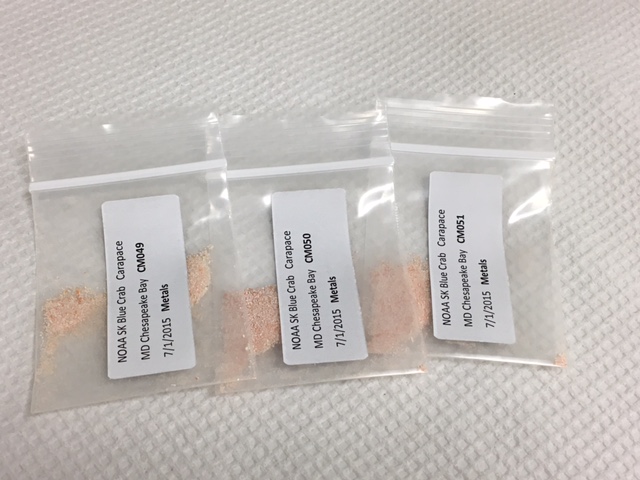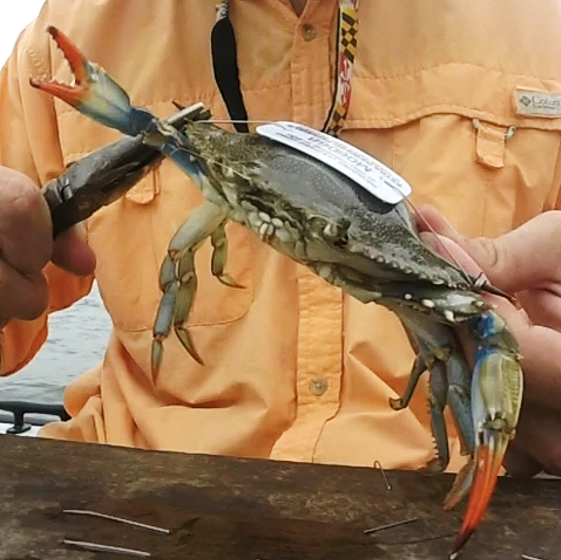- Home
- Research
- Projects
- Identifying Blue Crab Nursery Hot-Spots
- Identifying Blue Crab Nursery Hot-Spots
Identifying Blue Crab Nursery Hot-Spots
Project Title: Novel biogeochemical tracers used to identify which nursery habitats of the Chesapeake Bay produce the most female crabs that successfully complete their spawning migration.
Project Goal: To provide fishery managers with information on the relative nursery value of subestuaries of the Chesapeake Bay, with a particular focus on their contribution to the reproductive output of the blue crab spawning stock.
Project Description:
After mating, female blue crabs undergo a spawning migration from brackish water in places like the upper Chesapeake Bay to salty water near or in the ocean, where they release their young. Shortly after maturation and mating, female crab exoskeletons harden, taking on the chemical characteristics of places like the Rhode River, where SERC is located. Preliminary studies showed that this chemical signature remains stable over time, making it possible to catch females after they migrate and use the chemical signature to track them back to the nursery habitat where they mated. With this study, we are confirming the effectiveness of this method, and applying it to the first comprehensive study evaluating which nursery habitats of Chesapeake Bay produce the most female crabs that successfully complete their spawning migration. Determining where the most productive nursery locations are will help inform to rebuild and sustain the blue crab fishery, the most important fishery in the Chesapeake Bay.
Biogeochemical tracers

Blue crabs, like all crustaceans, grow through the process of molting, the periodic shedding of their rigid exoskeleton, often referred to as shell or carapace. While much of the exoskeleton is comprised of protein, chitin, and calcium salts, stable isotopes like carbon and nitrogen and trace elements like cadmium and zinc from the local area are also incorporated into the exoskeleton as it hardens. The ratios of these isotopes and elements differ among subestuaries of Chesapeake Bay. Thus, the composition of stable isotopes and trace elements in a crab’s exoskeleton can act like a natural location tag, or signature, when analyzed in the lab.
The stable isotope and trace element signatures of animal tissues and hard parts have been used to trace the origins and movements of both terrestrial and aquatic animals. This biogeochemical signature technique hasn’t been used in crustacean studies because of the difficulties associated with an organism that molts regularly throughout its lifetime. However, because female blue crabs stop molting after they mature and mate, we can apply this signature technique to the study of the female blue crab spawning migration.
The biogeochemical signature of recently-molted mature female crabs was determined for locations around Chesapeake Bay to determine site by site variation in signatures. Then, a large number of crabs was sampled in the spawning area, and the chemical composition of their shells was used to trace them back to the place where each crab likely molted to maturity. Once this is done for hundreds of crabs, we will use this information to determine which parts of Chesapeake Bay contributed the highest proportion of females to the spawning stock.
Mark-recapture study

A large-scale mark-recapture experiment was used to evaluate how reliable biogeochemical signatures can be for tracing mature female crabs back to their nursery habitat. Several thousand tagged crabs were released at the same time that samples were collected to evaluate biogeochemical signatures. When crabs were caught by fishers as much as a year later, we tested our ability to map them back to their release location using only the chemical signature of their shell. If crabs from known locations can successfully be mapped back to nursery habitats, the method can be used to study which nursery habitats contribute most to the spawning stock.
